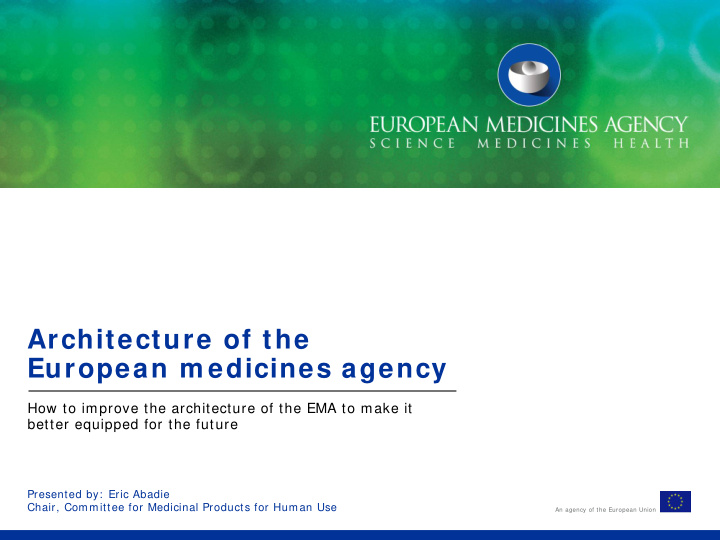



Architecture of the European m edicines agency How to improve the architecture of the EMA to make it better equipped for the future Presented by: Eric Abadie Chair, Committee for Medicinal Products for Human Use An agency of the European Union
Objectives of the topic • To discuss issues facing scientific committees of the Agency with regards to com plex interactions and w orkload • To exchange views on recommendations proposed in the Agency’s evaluation report and consider other ideas to assure long term sustainability of the system Architecture of the European medicines agency 2
Strengths of the system • The European Medicines Agency, as a whole including the contribution of 44 National Competent Authorities throughout the 27 EU Member States and the 3 EEA-EFTA countries and the EMA Secretariat, is the archetype of an effective Com m unity m odel with concrete and regular outputs • It provides with complete, clear and highly valued opinions within regulatory tight deadlines and allows the contribution of the best available experts in Europe • The present evaluation confirms the operational effectiveness of the system as a whole.The effectiveness of the system has been maintained despite its grow ing com plexity Architecture of the European medicines agency 3
Overview of challenges in the context of the architecture of the system • Issue 1: Is the organisation of the committee system too com plex leaving opportunity to improve interrelations among the committees and working parties, reduce overlapping in roles and responsibilities and reduce possible duplication of effort • Issue 2: Is the current architecture of committees optimal to assure the capacity to deal with w orkload and the availability of best scientific expertise now and long-term. Architecture of the European medicines agency 4
Issue 1: Complex organisation of the committee system - reasons Gradual evolution of legislation and responsibilities of the EMA • CHMP, CVMP – 1995 • COMP – 2000 • HMPC – 2004 • PDCO – 2007 • CAT – 2009 • Pharmacovigilance committee – to come Architecture of the European medicines agency 5
Issue 1: Complex organisation of the committee system - result • Challenges ensuring consistency of opinions and guidelines, and continuity of decisions • Challenges ensuring coordination between committees and working parties • Duplication of work Architecture of the European medicines agency 6
Issue 1: Complex organisation of the committee system National competent authority MAA Phase R&D Phase 1995 Pre-submission EMEA SME Paediatrics Rapporteur Pre- Paediatrics Office nomination submission OD ITF SA FUSA SA EMEA EMEA R&D Phase MAA Phase 2010 Certificate Certificate Variations SME - ATMP SME - ATMP Architecture of the European medicines agency 7
Issue 1: Complex organisation of the committee system – areas for reflection • How linkages of the committees can be improved? • Can the architecture of working parties be improved? • Do we need to change architecture of current committees: [ opinion making] committees, pre- committees and working parties? • Do we need to revisit the issue of membership: expert-based membership vs Member State-based membership? • Role and responsibilities of the secretariat Architecture of the European medicines agency 8
Issue 2: Adequate organisation of the system to respond to workload– reasons • Number and the diversity of tasks of the committees has increased significantly. – New tasks: paediatric medicines, advanced therapies, herbal medicines, cumulative post-authorisation work, generic applications, increase in referrals. – Gradual shift to new therapies will further add strain on committees and their expertise. • Resources at NCA level are not increasing • Diverse contribution of national competent authorities Architecture of the European medicines agency 9
Issue 2: Adequate organisation of the system to respond to workload– result • Capacity of CHMP and CVMP is reaching limits – In terms of ability to handle the number of issues at the meetings – May affect the quality of opinions long-term – May risk the ability to comply with legislative deadlines in the future • Establishment and potential impact of the new pharmacovigilance committee Architecture of the European medicines agency 10
Issue 2: Adequate organisation of the system to respond to workload– areas for reflection • Do we need to establish subcommittees to deal with specific types of applications? • Do we need new ways of working, e.g. cross border cooperation? • Do we need to change meeting practices, and also use more extensively alternative meeting solutions? • Do we need to revise roles and responsibilities of the secretariat and integration of its work? Architecture of the European medicines agency 11
Issue 2: Adequate organisation of the system to respond to workload– areas for reflection • Should committee members become ‘full time’ members? • Do we need to compensate for certain activities that are currently not compensated? • Can we improve targeted training in the network to respond to medium and long term needs? Architecture of the European medicines agency 12
Recommendations from the evaluation of the Agency Architecture of the European medicines agency 13
Topics from the evaluation report on Architecture and workload for discussion • Establishing committee (CHMP, COMP, CVMP,HMPC) and pre-committee structure (PDCO, CAT) ( recommendation 1,3) • Temporary subcommittees for referrals and generics ( recommendation 5) • Member-based membership for committees and expert-based membership for pre-committees ( recommendation 2,4) • ‘Full time’ members of the committees ( linked to recommendation 7 ) Architecture of the European medicines agency 14
Other topics from the evaluation report for discussion • Improving dialogue and interactions with industry throughout lifecycle of medicines ( recommendation 17, 19) • Transparency of the rapporteur appointment procedures ( recommendation 27) • Role of EMA secretariat ( recommendation 13, 15, 20) Architecture of the European medicines agency 15
Recommend
More recommend